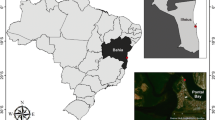Abstract
Postlarval and juvenile grass shrimp (Palaemonetes pugio Holthuis) ≦15 mm total length (TL) were abundant at low tide in shallow aquatic microhabitats (i.e. puddles and films of residual tidal water) in the intertidal zone of a salt marsh on Sapelo Island, Georgia, USA from 1982 to 1984. The highest concentrations of young P. pugio occurred at 190 to 200 cm above mean low water, ∼10 to 20 cm below mean high water. The intertidal distributions of young grass shrimp expanded and contracted with changes in tidal amplitude. Postlarval grass shrimp (6 to 8 mm TL) continuously recruited into the intertidal marsh population from May until October, but densities varied in a regular pattern with peaks in abundance occurring at ∼2-week intervals, corresponding to spring tide periods in the lunartidal cycle. Although present nearly year-round in the intertidal marsh, juveniles (9 to 15 mm TL) were most abundant from August to October. Apparent growth rates of individuals up to 15 mm TL averaged 0.268±0.026 (mean±95% C.I.) mm d-1 from May to October and 0.070±0.032 mm d-1 in November and December. Unlike larger aquatic organisms, which can forage in the emergent marsh only when it is flooded by the tide, juvenile grass shrimp have constant access to intertidal resources. Although potentially important predators in this system, the role of young P. pugio in the trophic organization of salt marsh benthic invertebrate assemblages has yet to be examined.
Similar content being viewed by others
Literature cited
Alon, N. C. and S. E. Stancyk: Variation in life-history patterns of the grass shrimp Palaemonetes pugio in two South Carolina estuarine systems. Mar. Biol. 68, 265–276 (1982)
Bell, S. S. and B. C. Coull. Field evidence that shrimp predation regulates meiofauna. Oecologia (Berl.) 35, 141–148 (1978)
Broad, A. C.: Larval development of Palaemonetes pugio Holthuis. Biol. Bull. mar. biol. Lab., Woods Hole 112, 144–161 (1957a)
Broad, A. C.: The relationship between diet and larval development of Palaemonetes. Biol. Bull. mar. biol. Lab., Woods Hole 112, 162–170 (1957b)
Chatfield, C.: An analysis of time series: an introduction, 286 pp. New York: Chapman and Hall 1984
De Coursey, P. J. (ed.): Biological rhythms in the marine environment, 283 pp. Columbia, SC: University of South Carolina Press 1976
Heck, K. L. Jr. and T. A. Thoman: Experiments on predator-prey interactions in vegetated aquatic habitats. J. exp. mar. Biol. Ecol. 53, 125–134 (1981)
Kleypas, J. and J. M. Dean: Migration and feeding of the predatory fish, Bairdiella chrysura Lacepede, in an intertidal creek. J. exp. mar. Biol. Ecol. 72, 199–209 (1983)
Kneib, R. T.: Patterns in the utilization of the intertidal salt marsh by larvae and juveniles of Fundulus heteroclitus (Linnaeus) and Fundulus luciae (Baird). J. exp. mar. Biol. Ecol. 83, 41–51 (1984a)
Kneib, R. T.: Patterns of invertebrate distribution and abundance in the intertidal salt marsh: causes and questions. Estuaries 7, 392–412 (1984b)
Kneib, R. T.: Predation and disturbance by grass shrimp, Palaemonetes pugio Holthuis, in soft-substratum benthic invertebrate assemblages. J. exp. mar. Biol. Ecol. 93, 91–102 (1985)
Kneib, R. T.: Predation risk and use of intertidal habitats by young fishes and shrimp. Ecology 68, 379–386 (1987)
Kuenzler, E. J.: Structure and energy flow of a mussel population in a Georgia salt marsh. Limnol. Oceanogr. 6, 191–204 (1961)
Leber, K. M.: The influence of predatory decapods, refuge, and microhabitat selection on seagrass communities. Ecology 66, 1951–1964 (1985)
Macdonald, P. D. M. and T. J. Pitcher: Age-groups from size-frequency data: a versatile and efficient method of analyzing distribution mixtures. J. Fish. Res. Bd Can. 36, 987–1001 (1979)
Main, K.: Predator avoidance in seagrass meadows: prey behavior, microhabitat selection, and cryptic coloration. Ecology 68, 170–180 (1987)
Mayer, M.: Ecology of juvenile white shrimp, Penaeus setiferus Linnaeus, in the salt marsh habitat. M. S. thesis, 74 pp. Atlanta, GA: Georgia Institute of Technology 1985
Meadows, P. S. and J. I. Campbell: Habitat selection by aquatic invertebrates. Adv. mar. Biol. 10, 271–382 (1972)
Menge, B. A.: Predation intensity in a rocky intertidal community. Oecologia (Berl.) 34, 1–16 (1978)
Morgan, M. D.: Grazing and predation of the grass shrimp Palaemonetes pugio. Limnol. Oceanogr. 25, 896–902 (1980)
Nelson, W. G.: Experimental studies of selective predation on amphipods: consequences for amphipod distribution and abundance. J. exp. mar. Biol. Ecol. 38, 225–245 (1979)
Nixon, S. W. and C. A. Oviatt: Ecology of a New England salt marsh. Ecol. Monogr. 43, 463–498 (1973)
Odum, W. E. and E. J. Heald: Trophic analysis of an estuarine mangrove community. Bull. mar. Sci. 22, 671–738 (1972)
Peterson, C. H.: The importance of predation and competition in organizing the intertidal epifaunal communities of Barnegat Inlet, New Jersey. Oecologia (Berl.) 39, 1–24 (1979)
Sandifer, P. A. and T. I. J. Smith: Possible significance of variation in the larval development of palaemonid shrimp. J. exp. mar. Biol. Ecol. 39, 55–64 (1979)
Sikora, W. B.: The ecology of Palaemonetes pugio in a southeastern salt marsh ecosystem with particular emphasis on production and trophic relationships, 122 pp. Ph. D. dissertation. Columbia, S.C.: University of South Carolina 1977
Van Dolah, R. F.: Factors regulating the distribution and population dynamics of the amphipod Gammarus palustris in an intertidal salt marsh community. Ecol. Monogr. 48, 191–217 (1978)
Welsh, B. L.: The role of grass shrimp, Palaemonetes pugio, in a tidal marsh ecosystem. Ecology 56, 513–530 (1975)
Williams, A. B.: Shrimps, lobsters, and crabs of the Atlantic coast of the eastern United States, Maine to Florida, 550 pp. Washington, DC: Smithsonian Institution Press 1984
Wood, C. E.: Physioecology of the grass shrimp Palaemonetes pugio, in the Galveston Bay estuarine system. Contrib. Mar. Sci., Univ. Texas 12, 54–79 (1967)
Author information
Authors and Affiliations
Additional information
Communicated by J. M. Lawrence, Tampa
Contribution No. 576 of the University of Georgia Marine Institute
Rights and permissions
About this article
Cite this article
Kneib, R.T. Seasonal abundance, distribution and growth of postlarval and juvenile grass shrimp (Palaemonetes pugio) in a Georgia, USA, salt marsh. Mar. Biol. 96, 215–223 (1987). https://doi.org/10.1007/BF00427021
Accepted:
Issue Date:
DOI: https://doi.org/10.1007/BF00427021




